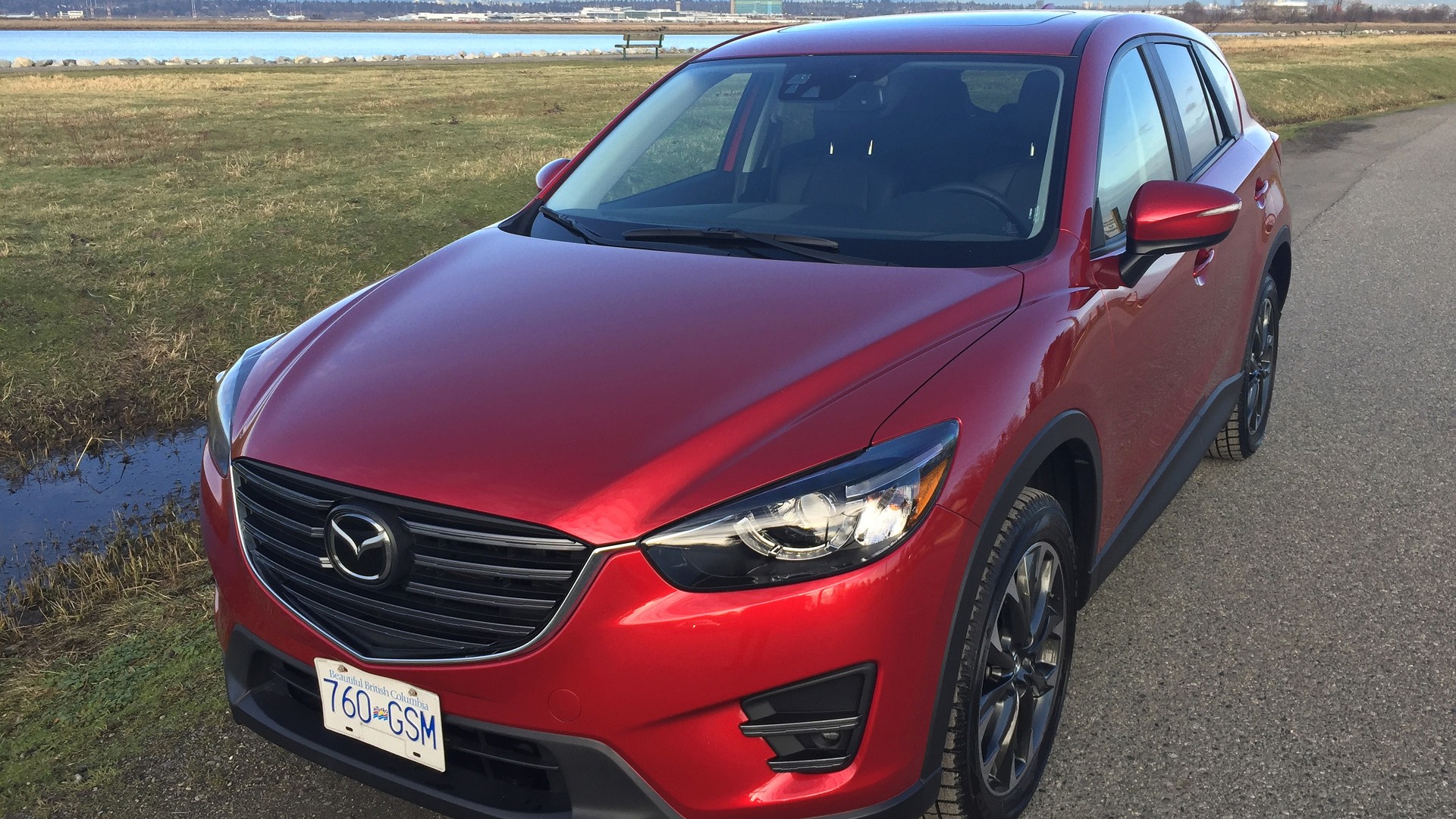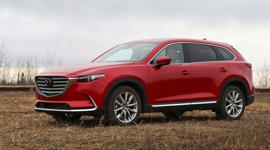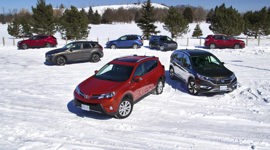 AutoTrader SCORE
AutoTrader SCORE
-
EXTERIOR STYLING8/10
-
INTERIOR8/10
-
PERFORMANCE7/10
-
COMFORT7/10
-
FUEL ECONOMY7/10
Here at autoTRADER.ca, the Mazda CX-5 is one of our favourite crossovers: in our 2013 and 2015 comparison tests of seven popular crossovers, the CX-5 won first and third places respectively. But it’s been four years since the CX-5 was first introduced and upgrades were needed to keep it from falling behind newer models. Perhaps the most significant upgrade for 2016 is Mazda’s next-generation car connectivity system, which includes a 7-inch touchscreen now operated by a control dial positioned on the centre console. Other improvements for 2016 address some of the criticisms we had of the CX-5: more sound insulation to reduce interior noise; more interior storage spaces; a new electronic parking brake button that frees up space in the centre console; and tweaks to the suspension and seats that improve the previously firm ride.
The 2016 CX-5 continues to offer 2.0-litre (GX) and 2.5-litre (GS, GT) four-cylinder engines and a standard six-speed manual transmission (GX only), but the six-speed automatic transmission (optional GX, standard GS, GT) now has a new Sport mode to improve acceleration and highway passing performance. As well, the AWD system (optional GX, GS, standard GT) uses a new low-viscosity oil that contributes to better fuel economy.
Some upgrades for 2016 apply only to the top-of-the-line CX-5 GT trim, including new LED headlights, LED fog lights and LED taillights; better-looking, larger-diameter 19-inch tires and alloy wheels; and upgrades to driving safety that include new Radar Cruise Control and Smart Brake Support (automatic braking at mid to high speeds).
The 2016 CX-5’s base price remains the same as last year, but MSRPs have increased by $350 on mid-level GS and by $1,400 on top GT trims due to additional standard equipment. 2016 MSRPs range from $22,995 (GX FWD manual transmission) to $36,995 (GT AWD automatic transmission) plus options, $1,895 Freight and PDI charge, $100 a/c levy, and relevant taxes.
With a base price of just $22,995, the CX-5 GX FWD would seem to be a good buy: it comes with a fuel-efficient 155-hp 2.0-litre 4-cylinder ‘SkyActiv’ engine and 6-speed manual transmission. Standard equipment includes 17-inch tires and steel wheels, keyless entry, pushbutton ignition, black fabric seats, AM/FM/CD with four speakers, air conditioning, power windows, power heated mirrors, cruise control, USB, electronic parking brake, auxiliary and 12-volt ports, manual height-adjustable driver’s seat, tilt/telescopic steering wheel, centre console/armrest and storage bin, and 60/40 split folding rear seatbacks.
However, the GX doesn’t have the new HMI console controller and 7-inch touchscreen or alloy wheels as standard equipment. Those come with the optional Convenience Package ($1,900) that also includes Bluetooth audio, HD radio, steering wheel controls, and tinted privacy windows. If you want the optional 6-speed automatic transmission ($1,300) you must also order the Convenience Package ($1,900). That brings the GX FWD Automatic price to $26,195. Add all-wheel drive and the price rises to $28,195.
Aside from all that, the base 155-hp 2.0-litre engine in the GX feels underpowered when passing and climbing hills, and for that reason alone we’d recommend the GS or GT trims which come standard with a 184-hp 2.5-litre four-cylinder engine and a six-speed automatic transmission.
The mid-level CX-5 GS trim ($29,245 FWD/$31,245 AWD) includes all of the features in the GX with the Convenience Package. It also adds front fog lights, automatic headlights, rearview camera, Blind-Spot monitor and Rear Cross-Traffic Alert warning systems, premium cloth upholstery, heated front seats, 6-way power driver’s seat with manual lumbar adjuster, height-adjustable front passenger seat, alarm, rain-sensing wipers, power moonroof, second USB port, two additional speakers, and 40/20/40 split-folding rear seatbacks.
Optional on the GS is a Luxury Package ($1,600) which includes leather seats, leather-wrapped steering wheel and shift knob, and power driver’s seat with power lumbar. But unless you want really want leather, we’d recommend skipping the Luxury Package and going with the standard fabric seats (which have new seat inserts for 2016). Compared to leather, the fabric seats feel warmer when you first sit in the car on a cold morning - though both have standard seat heaters.
The top-of-the-line CX-5 GT trim ($34,895) includes standard all-wheel drive and everything in the GS plus 19-inch all-season tires and alloy wheels, LED headlights with automatic leveling, LED fog lights, LED tail lights, leather seats, power driver’s seat, Bose premium audio system with nine speakers, dual-zone automatic climate control, and new standard voice-activated Navigation system.
Only the GT is available with the new i-Activsense safety features in the optional Technology Package ($2,100). These include Smart City Brake Support, Smart Brake Support, Radar Cruise Control, Forward Obstruction Warning, Lane Departure Warning, and automatic High Beam Control.
Strangely, SiriusXM satellite radio (with free 6-month subscription) is only available as part of the Technology Package in the GT trim.
Our tester, a top-of-the-line CX-5 GT AWD automatic, included the optional Technology Package ($2,100) and Soul Red Mica paint ($300). With a Freight charge of $1,895 and a/c tax of $100, the as-tested price came to a fairly hefty $39,290.
You’ll need a sharp eye to spot the styling differences between the 2015 and 2016 CX-5. The front grille now has five metallic grey slats instead of a honeycomb design, darker headlight surrounds, new fog light inserts and slightly different tail lights. GT trims also include the unique 19-inch alloy wheels, LED daytime running lights and LED tail lights. Overall, the CX-5’s design has held up well over the years - to these eyes, it still looks contemporary and attractive.
All CX-5s include the convenience of remote keyless door locking and unlocking by pressing a button on the keyfob. GT models can also be locked and unlocked by pressing a black button on the door handle - once to open the driver’s door and twice to unlock all the doors and the trunk.
Four big doors allow easy access to the front and rear seats. Note that the bottom of the doors covers the lower side sills so that they remain clean. That prevents grime from soiling the bottom of your pant legs or coat when getting in and out - a great idea! [Jonathan wishes the Hyundai Tucson long-termer was so designed... –Ed.]
Second Opinion: 2016 Mazda CX-5 Test Drive
The CX-5 has plenty of headroom and legroom front and rear for four adult passengers, although it’s not the roomiest crossover in its class and the rear seats don’t slide fore and aft like they do in some competitors. The front seats are very comfortable and in the GT, the driver’s seat includes power height, fore-aft, rake and lumbar adjustments. But even in the GT, the front passenger seat has no power adjustments; it does have a manual height adjuster. At the rear, I found the seatbacks firmer than in the front but the cushions are quite comfortable; for 2016, Mazda increased the length of the rear seat cushions to improve comfort.
The CX-5’s interior is very nicely finished with a clean, uncluttered appearance. In the GT, you have a choice of black or white leather (including new parchment leather) while all other CX-5 trims receive black fabric seats with new seat inserts. Niceties include padded door armrests and centre armrest, soft-touch dash, tasteful use of bright trim, a bright 3-gauge instrument cluster with information display, and a roomy open storage bin at the bottom of the centre console where you can store your electronic devices. GS and GT trims are supposed to include a 12-volt powerpoint here, but I couldn’t find it. I did see two USB ports, an auxiliary port and an SD car slot. Between the front seats is a padded armrest which lifts up to reveal a removable coin tray and a deep bin.
The new 7-inch touchscreen in the dash is no longer surrounded by buttons and dials, which gives the dash a cleaner and more modern look. You can only operate the on-screen ‘buttons’ when the vehicle is stopped, but it’s much easier to navigate through the various screen menus by turning/pushing/pressing the silver dial in the centre console. The dial is positioned so that the driver’s right hand falls onto it without any unnecessary reaching or stretching. Around the dial are buttons for shortcuts to major functions including Home, Audio, Navigation and Back, as well as a small dial for audio Volume.
With its large, bright script and images, the 7-inch colour screen is easy to read from a distance. The Home screen features five circular main menus arranged in a semi-circle: Apps, Music, Telephone, Navigation, and Settings. Using the dial on the centre console, the driver can scroll left and right between menus and press the dial to select. It’s easy to find the radio station or media choice you want, or view a real-time navigation map in 2D or 3D with your current position and location. A menu bar at the bottom of the screen can be made to disappear to allow a full-screen view (such as for the map). An interesting feature of the navigation map is a real-time Speed Limit sign that changes colour if you go over the speed limit! You can also view your current and average fuel economy. As well, smartphone apps can now be operated through the new HMI system. It doesn’t take long to learn Mazda’s HMI system and you likely won't even have to read the owner’s manual.
Aside from the HMI controller, you can also use the buttons on the steering wheel to do common tasks while you’re driving, like adjusting radio volume, seeking the next radio station or track, initiating hands-free (Bluetooth) telephone calls, and activating cruise control. Voice activation can be used to make telephone calls or to plot a route to your destination using the navigation system.
The climate control system which sits below the screen is independent of the HMI controller and touchscreen. It’s easy to operate with large dials and pushbuttons. There are also buttons for the front seat heaters with three temperature choices.
While the GX trim has standard 60/40 split folding rear seatbacks, GS and GT trims have 40/20/40 split folding rear seatbacks; these permit longer items like skis or snowboards to be transported in the middle enabling two rear passengers to sit in the more-comfortable outboard rear seats. The rear seats can be dropped while standing at the rear by pulling levers on the cargo walls.
The cargo area itself is a roomy 966 litres behind the rear seats and up to 1,852 litres with the rear seats folded down. It has a fabric-lined floor (our test vehicle had an optional rubber floor liner) and lined rear seatbacks but the wheel-housings are plastic. The rear liftgate is easy to lift up, suspended by hydraulic struts that don’t impede the cavernous cargo opening. A power liftgate is not offered. I was surprised to see that a cargo privacy cover is not standard equipment - it’s an optional accessory for $254.
In the driver’s seat, visibility is good except to the rear where a combination of bulky outboard head restraints, a thick C pillar and a high window ledge conspire to reduce visibility. In bad weather, a standard rear wiper/washer with an intermittent wipe setting is very useful when driving in the rain (or snow) particularly at night. A rearview camera is also helpful when parking, but on rainy days, the rear view is obscured by water on the lens.
With the key fob in your pocket, start the engine by pressing the pushbutton ignition. The 2.5-litre four-cylinder engine growls for a few minutes when it’s cold, then changes to a muted buzz when it warms up, and is almost silent at cruising speeds. In everyday driving, I noticed a substantial improvement in cabin quietness over last year’s model. Mazda claims interior noise has been reduced by 10 percent compared to the previous model.
Acceleration is brisk and more than powerful enough for typical freeway merging and passing. During my week-long test-drive of mixed city and highway driving, the average fuel consumption readout of 9.4 L/100 km was close to the official NRCan rating of 9.8 city/7.9 hwy/9.0 combined.
The six-speed automatic transmission shifts very smoothly, but I wasn’t impressed with the new Sport mode. By pressing the Sport button on the console, the transmission drops a gear or two and maintains higher revs, even while cruising. Acceleration is better but at the cost of more noise and worse fuel economy. Whereas the engine turns over about 2,000 rpm at 100 km/h in normal mode, revs rise to almost 3,500 rpm in Sport mode. In my opinion, the CX-5’s combination of performance and fuel economy is just fine without the Sport mode.
Ride comfort has improved. The ride used to be quite firm (though not harsh) over pavement breaks and potholes but now absorbs bumps with less shock intrusion. That hasn’t affected the handling though: with a fully independent suspension, it’s still a comparatively agile and responsive crossover that maintains its composure in spirited driving. From the occupants’ perspective, the combination of its improved ride and quieter cabin gives the 2016 CX-5 a more upscale feel.
Mazda’s i-ACTIV all-wheel-drive system is a sophisticated on-demand system that runs in front wheel drive most of the time to maximize fuel economy, but is capable of automatically directing power to the rear wheels when road conditions get slippery. Using a variety of sensors, i-ACTIV AWD can detect, and even predict, when road conditions are worsening. For example, it monitors the outside temperature, wiper operation, hill grade, engine load, steering wheel angle, and brake pressure. During my test drive in typically wet January weather conditions in Vancouver, I experienced excellent grip and control. There was no snow in Vancouver, so I’ll have to leave that up to our writers in the ROC.
Unlike some compact SUVs, the CX-5 does not have a driver-selectable differential lock which splits torque 50/50 front/rear. This can be useful in deep snow or slippery hills. However, CX-5 AWD models do have a decent 210 mm (8.2 in.) ground clearance.
My CX-5 GT was equipped with Toyo Observe GSi-5 225/55R-19 inch uni-directional winter tires which gripped well in the above-mentioned weather conditions. I was surprised because I tested this same tire in my recent review of the Toyota Yaris Sedan, and wasn’t impressed with the grip. They were much narrower though - 185/60R-16-inch - and the Yaris didn’t have all-wheel drive.
During night-time driving, the GT’s LED headlights provide an almost-180-degree swath of bright illumination with a sharp upper cut-off for the low beams. High beams add a bright upper illumination. These are really excellent headlights, and in the GT they automatically dip from high beam to low beam when another vehicle approaches from the opposite direction.
The CX-5’s active safety features are designed to warn of an impending collision and/or prevent an impending collision by using laser, radar and camera sensors. Standard on GS and GT trims are Blind Spot Monitoring (BSM) and Rear Cross-Traffic Alert (RCTA). The former illuminates yellow warning lights in the side mirrors when another vehicle is in the blind spot. The lights will flash and buzzers sound if you attempt to cross into the next lane. Rear Cross-Traffic Alert (RCTA) sounds an alarm if you attempt to back up while another vehicle is crossing behind you. These warning devices act like eyes in the back of your head by watching blind spots that you might miss.
Optional in the GT Technology Package is Lane Departure Warning System (LDWS) which sounds a warning tone and/or a rumbling sound through the speakers if your vehicle wanders across the lane marker. At speeds under 30 km/h, Smart City Brake Support (SCBS) will prime the brakes and even stop the car automatically if the driver doesn’t brake in time.
New in the Technology Package for 2016 is Smart Brake Support (SBS) which can automatically activate the brakes at medium to high speeds (15 to 145 km/h). Using a radar sensor, it can detect vehicles and obstacles up to 200 metres ahead. If your vehicle is approaching another too quickly, a warning "Brake!" light flashes in the instrument cluster. If you don’t brake, the SBS will automatically brake and (hopefully) avoid a collision.
SBS works in conjunction with Mazda Radar Cruise Control (MRCC) which automatically maintains a steady following distance between the CX-5 and the car ahead. Using a button on the steering wheel, the driver can preset one of four following distances. This system is best used on the freeway where speeds are fairly constant and there are few stops.
Mazda is careful to point out that all these systems have their limitations and not all collisions can be prevented. Bad weather, road conditions, and even the shape of the vehicle ahead can disable the sensors.
As you can see, the Mazda CX-5 combines utility, comfort and drivability in a very attractive fashion. But if you want all the bells and whistles in the CX-5 GT, you’re looking at almost $40,000 plus taxes. That makes it one of the priciest crossovers in its class and not too far away from compact luxury SUVs like the Acura RDX and Lexus NX. That might give some people pause.
| Warranty: 3 years/unlimited km; 5 years/unlimited km powertrain; 7 years/unlimited distance corrosion perforation; 3 years/unlimited km roadside assistance Competitors: |
| Model Tested | 2016 Mazda CX-5 (GT AWD 6 auto) |
|---|---|
| Base Price | $30,690 |
| A/C Tax | $100 |
| Destination Fee | $1,895 |
| Price as Tested | $39,290 |
|
Optional Equipment
$2,400 (Technology Package $2,100; Soul Red Mica paint $300)
|
|































































